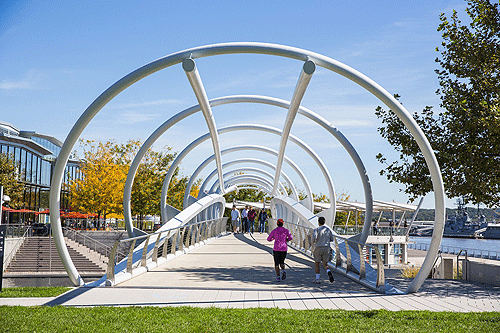From Contaminated to Revitalized: The Story of The Yards
By Barbara Smith

Have you ever wondered how visions like this become realized?
This is the story of how the U.S. Government is partnering with private sector developers to transform a once-contaminated property on the Anacostia River in Washington, DC, into a vibrant riverfront destination/community.
Believe it or not, the vision for a vibrant riverfront community came from this brown space, the Washington Navy Yard (WNY).
In early 1960’s, the WNY, located in southeastern Washington, DC, was recommissioned from its former use as a weapons manufacturing site to its current use as a Navy office/administration location. As part of the transition, in 1963, the WNY transferred 55 “excess” acres to the U.S. General Services Administration (GSA) to develop into federal office space. The GSA named its new acquisition the Southeast Federal Center (SEFC).

However, the 55 acres had been heavily industrialized, with many abandoned factory buildings where ship boilers and large naval guns were manufactured from pre-World War One to post-World War Two. When GSA received the property in 1963, there were no regulations governing the clean-up of contaminated properties or how to identify and investigate contamination on these properties. Without funding to transform the former industrial site into office space, GSA made little progress in developing the SEFC site to its full potential.

Then, in 2000, Congress passed the SEFC Public/Private Development Act to assist GSA in developing the area. The Act allowed GSA to partner with private sector developers to plan and develop the SEFC parcels for eventual sale or lease. GSA’s master plan shifted from creating federal offices to creating office, residential, retail and public uses for the site.
Since the federal government works to protect human health and the environment, GSA worked with us to properly assess the property and any contamination found. This assessment is in accordance with the requirements of the Resource Conversation and Recovery Act (RCRA).
GSA conducted a site-wide investigation and continues to clean up any contamination found on the individual parcels prior to development.
The investigation, conducted under our RCRA Corrective Action Program, found that previous intensive industrial use had left contaminants in the soil. The picture above shows soil testing taking place at the site to see which contaminants are present.

Several soil removals have been completed, including removing PCB-contaminated sediment from storm sewers and on-site soil contaminated with petroleum and metals. GSA continues to remove contaminated soil from the surface and at depth from parcels being prepared for development.

GSA removed an old wooden seawall on the Anacostia River and replaced it with a modern concrete and steel pier.
The above picture is the first parcel that was developed and sold, known as the “Department of Transportation (DOT) Parcel.” During the site investigation, groundwater contaminated with gasoline was found at levels above EPA drinking water standards. The sources of this contaminated groundwater were leaking underground storage tanks from an off-site former gas station and possibly some on-site contamination.
The groundwater has been treated and contaminant levels are stable or declining. The office building has a moisture/vapor barrier and is supplied by public water which ensures that workers and pedestrians are not exposed to contaminants.
The other developed portions of the SEFC are known as ‘The Yards’. The Yards is a part of the revitalization and redevelopment of properties along the Anacostia River in Washington, DC known as the Anacostia Waterfront Initiative, which includes the Nationals Baseball Stadium just down river, adjacent to The Yards. The Yards Park (shown above) is located within The Yards and includes an entertainment/performance area, boardwalk and now a marina. This public park was made possible by GSA, the developer, Forest City Washington and the city of Washington, DC.
The Anacostia River Trail is also a result of the redevelopment. This picture shows a section of the River Trail located by The Yards Park.

Almost half of The Yards development parcels are complete, with total build out scheduled for 2025. What was once an urban, industrial environment is now a revitalized area, anchored by redevelopment.
Our RCRA Corrective Action program continues to oversee the environmental investigation and clean-up process to ensure that development and future land use will be protective of human health and the environment.
About the author: For the last 15 of her 25 years with EPA Region 3, Barbara Smith has been working in the RCRA Corrective Action group, working with Facilities in transforming their contaminated properties into cleaner, safer places to live and work. Barbara looks forward to living in a log cabin in the middle of nowhere someday.









